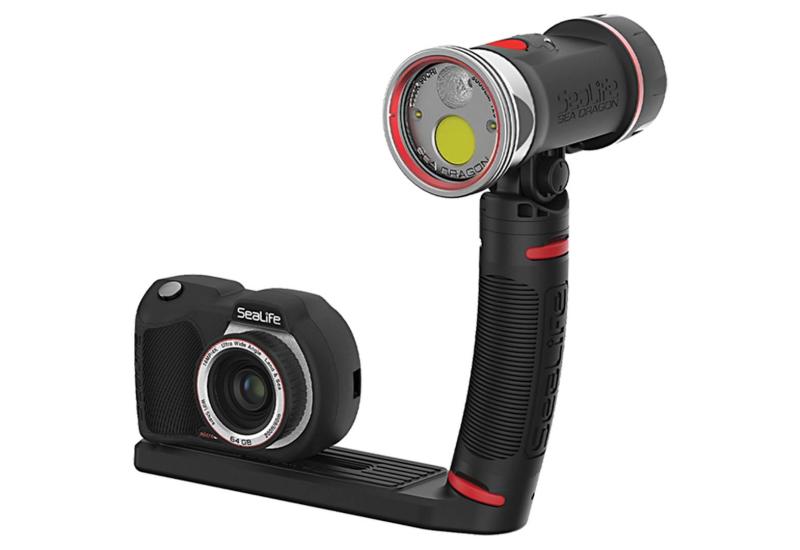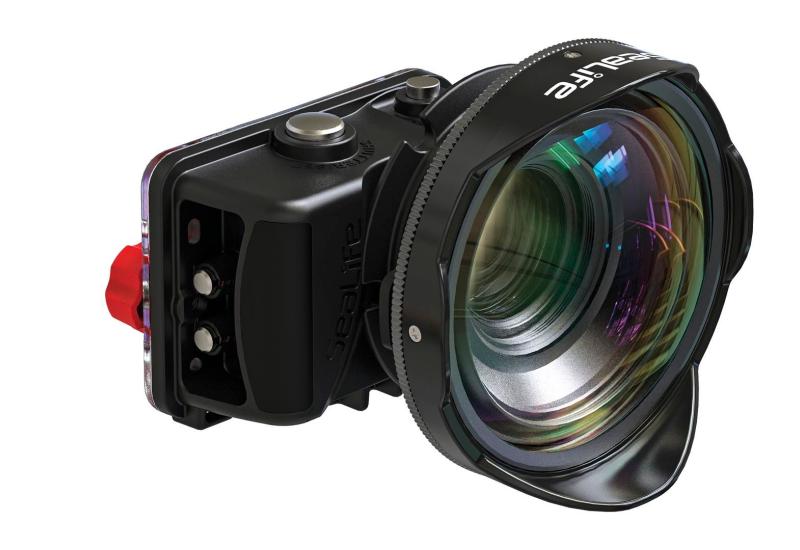ScubaLab: Underwater Camera Systems - Fisheye Fix for the Canon G11

Specifications
| Sensor | 10 MP, 7.6x5.7 mm CCD; 23 MP per square cm |
| Image Size | Large: 3,638x2,768 to 320x240 at lowest resolution |
| Sensitivity | ISO 80-3,200 |
| Image File Formats | JPEG: fine and normal; RAW |
| Auto Focus | 9-point AiAF, TTL |
| Exposure Modes | Multiple including Program, Aperture Priority, Shutter Priority, Manual, as well as 17 scene modes |
| White Balance | 11 including Auto, Underwater and Manual |
| Weight | 13.2 ounces |
| Monitor | 2.8-inch, 461,000 pixel LCD |
| Zoom | 28-140 mm |
| Video Mode | 640x480 or 320x240 (30 fps) |
| Special Features | Multiple storage types, anti-noise system, flash sync to 1/2000 of a second and shutter sync to 1/4000 of a second |
| System as Tested | Fisheye FIX G11 housing, Canon G11 camera, Inon Z-240 strobe, Fisheye FIX 165-degree wide-angle lens |
| Price as Tested | $2,896 |
| www.canon.com | |
| www.backscatter.com |
The Pros Say
This system’s major features include a large CCD sensor and ISO range. It is perfect for the intermediate-level photographer looking to step up from an entry-level system. With full manual control of settings, the G11 is a great option without taking the full leap into DSLR photography.
The Test Diver Says
This camera system came with a metal housing and dome port over the lens that gave the camera a compact and slightly negative profile underwater. The system included a strobe, which enabled me to see what the camera was capable of. The moment I hit the water, I was immediately struck by the depth-of-field. The dive site offered minimal visibility and little ambient light, and yet the camera managed to reflect atmospheric depth that captured the scope and size of the dive. The camera was responsive to small adjustments and allowed for lots of custom fine-tuning to capture the right color balance. The hardy metal housing closed with a loud and definitive click. This inspired confidence in the freshwater dunk tests we gave each system before hitting the water. Control knobs are pushed down, allowing for easy adjustments. The system, including strobe, was compact and streamlined enough to be easily carried on longer dives or when covering a lot of ground underwater. The camera was intuitive about capturing light. Because of the dive conditions, I assumed that any shot beyond a foot or so from the subject was going to have lots of backscatter and probably wouldn’t work. The camera proved me wrong. With the right adjustments, it was capable of a great range of depth and color contrast that made even our very dark dive spot produce photographs with surprising resolution and brightness. The shutter speed was also impressive, as I was able to capture shy fish movements easily. With just a twist of the knobs, I was able to access the menu screens, which offered a huge variety of custom adjustments as well as white balance and an underwater color mode. I was a bit overwhelmed with the choices, but after three dives with the camera, the layout of the screens and variety of modes allowed me to program many individual preferences and adjustments. And the shots that came out of this camera were so gorgeous that it just spurred me on to learn more. I told one of the ScubaLab photo pros that the camera essentially taught me how to use it. It was exciting to use a camera that delivered high-quality shots and yet was almost as easy to use as a point-and-shoot. I am a diver who likes to cover a lot of territory on my dives, and this camera was so light and easy to carry that I would carry it with me on all of my dives. In the past, I have been discouraged when I found the camera wasn’t able to capture what I was really seeing underwater, but this camera inspired me with all its capabilities. — Andrea Beck
| August 2010 Issue Scuba Lab Review Quick Links |
|---|
| Optical Cameras |
| --- |
| Canon Powershot D10| Fisheye Fix for the Canon G11 |
| Fisheye Fix for the Canon S90| Sea&Sea; DX-2G |
| Bonica for the Sony T90| |
| Micro Four-Thirds Camera |
| --- |
| Olympus PT-EP01 for the E-PL1 |
| Digital SLR Cameras |
| --- |
| Ikelite for the Nikon D90| Nauticam for the Canon 7D |

Specifications
| Sensor | 10 MP, 7.6x5.7 mm CCD; 23 MP per square cm |
| Image Size | Large: 3,638x2,768 to 320x240 at lowest resolution |
| Sensitivity | ISO 80-3,200 |
| Image File Formats | JPEG: fine and normal; RAW |
| Auto Focus | 9-point AiAF, TTL |
| Exposure Modes | Multiple including Program, Aperture Priority, Shutter Priority, Manual, as well as 17 scene modes |
| White Balance | 11 including Auto, Underwater and Manual |
| Weight | 13.2 ounces |
| Monitor | 2.8-inch, 461,000 pixel LCD |
| Zoom | 28-140 mm |
| Video Mode | 640x480 or 320x240 (30 fps) |
| Special Features | Multiple storage types, anti-noise system, flash sync to 1/2000 of a second and shutter sync to 1/4000 of a second |
| System as Tested | Fisheye FIX G11 housing, Canon G11 camera, Inon Z-240 strobe, Fisheye FIX 165-degree wide-angle lens |
| Price as Tested | $2,896 |
| www.canon.com | |
| www.backscatter.com |
The Pros Say
This system’s major features include a large CCD sensor and ISO range. It is perfect for the intermediate-level photographer looking to step up from an entry-level system. With full manual control of settings, the G11 is a great option without taking the full leap into DSLR photography.
The Test Diver Says
This camera system came with a metal housing and dome port over the lens that gave the camera a compact and slightly negative profile underwater. The system included a strobe, which enabled me to see what the camera was capable of. The moment I hit the water, I was immediately struck by the depth-of-field. The dive site offered minimal visibility and little ambient light, and yet the camera managed to reflect atmospheric depth that captured the scope and size of the dive. The camera was responsive to small adjustments and allowed for lots of custom fine-tuning to capture the right color balance. The hardy metal housing closed with a loud and definitive click. This inspired confidence in the freshwater dunk tests we gave each system before hitting the water. Control knobs are pushed down, allowing for easy adjustments. The system, including strobe, was compact and streamlined enough to be easily carried on longer dives or when covering a lot of ground underwater. The camera was intuitive about capturing light. Because of the dive conditions, I assumed that any shot beyond a foot or so from the subject was going to have lots of backscatter and probably wouldn’t work. The camera proved me wrong. With the right adjustments, it was capable of a great range of depth and color contrast that made even our very dark dive spot produce photographs with surprising resolution and brightness. The shutter speed was also impressive, as I was able to capture shy fish movements easily. With just a twist of the knobs, I was able to access the menu screens, which offered a huge variety of custom adjustments as well as white balance and an underwater color mode. I was a bit overwhelmed with the choices, but after three dives with the camera, the layout of the screens and variety of modes allowed me to program many individual preferences and adjustments. And the shots that came out of this camera were so gorgeous that it just spurred me on to learn more. I told one of the ScubaLab photo pros that the camera essentially taught me how to use it. It was exciting to use a camera that delivered high-quality shots and yet was almost as easy to use as a point-and-shoot. I am a diver who likes to cover a lot of territory on my dives, and this camera was so light and easy to carry that I would carry it with me on all of my dives. In the past, I have been discouraged when I found the camera wasn’t able to capture what I was really seeing underwater, but this camera inspired me with all its capabilities. — Andrea Beck
| August 2010 Issue Scuba Lab Review Quick Links |
|---|
| Optical Cameras |
| --- |
| Canon Powershot D10| Fisheye Fix for the Canon G11 |
| Fisheye Fix for the Canon S90| Sea&Sea; DX-2G |
| Bonica for the Sony T90| |
| Micro Four-Thirds Camera |
| --- |
| Olympus PT-EP01 for the E-PL1| |
| Digital SLR Cameras |
| --- |
| Ikelite for the Nikon D90| Nauticam for the Canon 7D |










